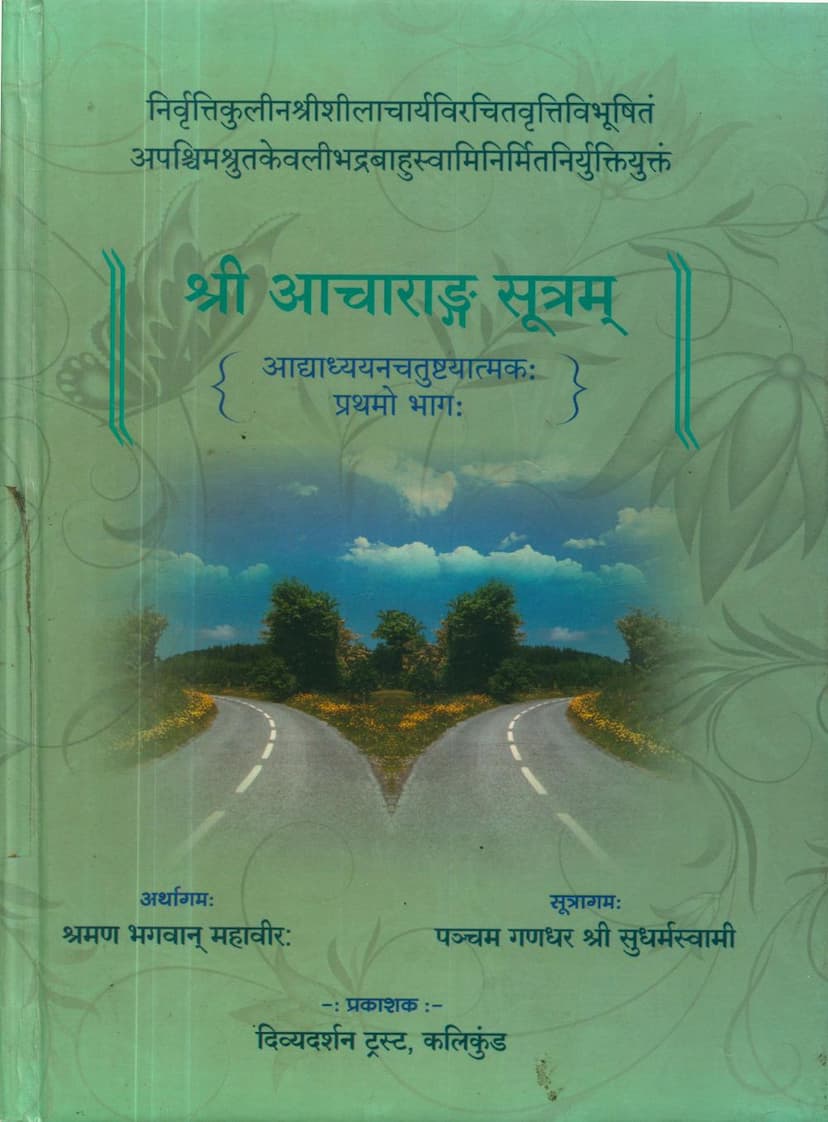Acharang Sutra Part 01
Added to library: September 1, 2025

Summary
Here is a comprehensive summary of the provided text from the Acharya Sutra, Part 01:
Book Title: Shri Acharaanga Sutra - Part 01 Author(s): Jaysundarsuri, Yashovijay Gani Publisher: Divyadarshan Trust Catalog Link: https://jainqq.org/explore/032460/1
This volume, the first part of the Shri Acharaanga Sutra, is presented with the commentary (Vritti) by Shri Shilaacharya and the Niryukti by the esteemed Shrutakevali Shri Bhadrabahuswami. It is published by Divyadarshan Trust in V.S. 2067 (2011 CE) and marks a significant contribution during the birth centenary year of Shri Bhuvanabhanusuri Maharaja.
The text is presented as a "Sutragam" (the scriptural text itself) by the fifth Ganadhara, Shri Sudharmaswami, and the "Arthagam" (the meaning and exposition) by Shraman Bhagavan Mahavir.
Core Teachings and Structure:
The Acharaanga Sutra is considered the essence of Jain teachings and the foundational text of the Charana-Karana (conduct and action) lineage of the twelve Angas of Jain scripture. This first part, particularly the first Shrutaskandha, lays the groundwork for the spiritual path of a monk (Shraman).
The volume contains the first Shrutaskandha of the Acharaanga Sutra, which comprises nine chapters (Adhyayanas). This particular publication covers the first four Adhyayanas of this Shrutaskandha, along with the extensive commentary by Shilaacharya.
Key Concepts and Chapters Covered in Part 01:
The four Adhyayanas covered in this part are:
-
Shastra Parigyna (शस्त्रपरिज्ञा): This chapter focuses on the concept of "weapons" (Shastra) in a philosophical sense. It delves into the Jiva (soul) and the non-living (Ajiva) and how actions (karma) bind the soul. It emphasizes the renunciation of violence (Himsa) in all its forms, particularly against the six types of living beings (Shadjeevakaya - Earth-bodied, Water-bodied, Fire-bodied, Air-bodied, Plant-bodied, and Moving beings). It details the various forms of violence and the consequences of such actions, highlighting the importance of ethical conduct, self-control, and non-violence (Ahimsa) for monks. The chapter elaborates on the nature of karma, the cycle of birth and death (Samsara), and the means to break free from it. It discusses the philosophical underpinnings of the soul, its existence, and the importance of right knowledge and conduct to attain liberation.
-
Lokavijaya (लोकविजय): This chapter focuses on the "victory over the world." In Jainism, "Lokavijaya" refers to the conquest of the inner world – the victory over passions (Kashayas) like anger, pride, deceit, and greed, as well as the senses and desires. It emphasizes the importance of maintaining equanimity (Samata) and detachment (Vairagya) in the face of worldly pleasures and pains, dualities (like heat and cold, pleasure and pain), and external circumstances. The text stresses the need for a monk to be vigilant against the allure of worldly attachments and to cultivate self-control and inner discipline to overcome them. It also touches upon the understanding of the universe and the principles of Jain cosmology and ethics.
-
Shitotiṣṇiya (शीतोष्णीय): This chapter deals with enduring "heat and cold," symbolizing the dualities of the world. It further elaborates on the importance of equanimity and indifference towards external circumstances like pleasant or unpleasant experiences, comfort or discomfort, honor or dishonor. The text stresses that true spiritual progress lies in maintaining a balanced state of mind, unaffected by external stimuli or internal passions. It highlights the need to understand the impermanent nature of worldly experiences and to cultivate inner strength to face life's challenges with equanimity. The chapter emphasizes that spiritual practice requires inner purity and detachment from worldly pleasures and pains.
-
Samyaktva (सम्यक्त्व): This chapter focuses on "Samyaktva," which translates to right faith, right knowledge, and right conduct. It emphasizes the foundational role of Samyaktva in the spiritual journey. The text explains that true understanding of the soul, karma, and liberation can only be achieved through the correct perception of reality, which is Samyaktva. It highlights the importance of avoiding wrong beliefs and practices that lead to further bondage. The chapter likely delves into the principles of Jain philosophy, including the nature of the soul, karma, liberation, and the path to achieve them through right conduct, knowledge, and faith. It emphasizes that mere adherence to rituals without the correct philosophical understanding (Samyaktva) is futile.
Commentary and Significance:
The text is enriched by the commentary of Shri Shilaacharya, who is renowned for his profound understanding of Jain Agamas. The commentary clarifies complex concepts, provides insights into the philosophical underpinnings of the teachings, and offers practical guidance for spiritual practice. The inclusion of Niryukti by Shri Bhadrabahuswami adds another layer of depth, offering verse-by-verse explanations and etymological insights into the scriptural text.
The publication also acknowledges the contributions of various scholars and institutions, including the former editors and researchers like Muni Shrimad Jambuvijayji Maharaja and Shri Amritlal Bhojak, and the inspiration from religious leaders like Acharya Shrimad Vijay Jayasundarsurishwarji Maharaja. The dedication to "Sansari Matushri Nandini ben" and the heartfelt gratitude expressed towards spiritual guides and patrons underscore the devotional and scholarly spirit behind this publication.
Overall Message:
The Acharaanga Sutra, Part 01, serves as a fundamental guide for aspiring monks and spiritual seekers. It emphasizes the paramount importance of ethical conduct, self-control, non-violence, equanimity, and right understanding (Samyaktva) as the cornerstones of the spiritual path. It provides a detailed framework for disciplined living and the gradual purification of the soul, leading towards ultimate liberation. The commentary and supporting materials offer a comprehensive resource for understanding these ancient and profound teachings.